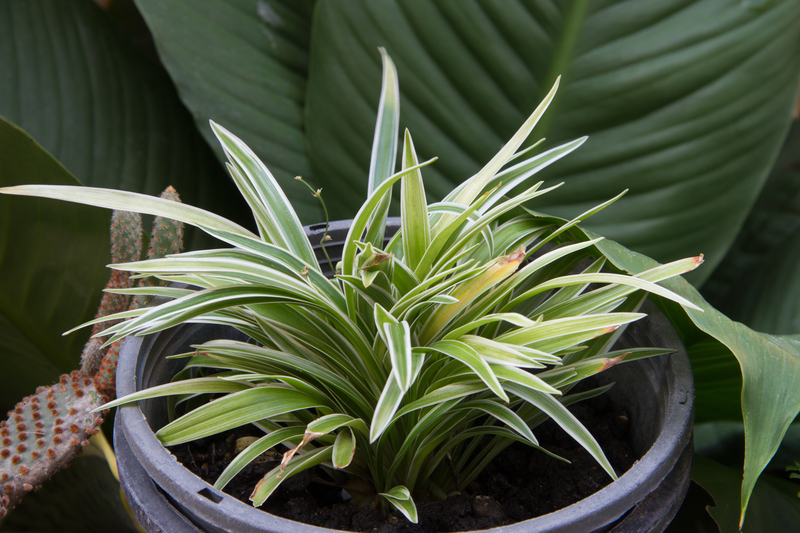Vertical Gardening: A Modern Approach to Green Spaces
Posted on 21/09/2025
Vertical Gardening: A Modern Approach to Green Spaces
Vertical gardening is rapidly revolutionizing the way we think about growing plants, especially in urban environments where space is limited. This modern approach to green spaces leverages vertical structures to cultivate plants upward, instead of outward, making it possible to enjoy lush gardens in high-rise apartments, small balconies, office walls, and other compact areas. In this comprehensive guide, we'll explore the benefits of vertical gardens, setup ideas, best plant choices, maintenance tips, and how they contribute to a greener, more sustainable urban landscape.

What Is Vertical Gardening?
At its core, vertical gardening is the practice of growing plants vertically, often using walls, fences, trellises, towers, or specially designed frames. This strategy enables garden enthusiasts and city dwellers to maximize limited space and introduce vegetation where traditional gardens are not feasible. From aesthetic vertical garden walls to practical herb towers in kitchens, the possibilities are endless.
The Evolution of Green Spaces
Green spaces have always played a crucial role in improving environmental quality and human wellbeing. However, as urbanization accelerates, traditional gardening methods become challenging due to space constraints. Vertical gardening emerges as a solution that aligns with modern living, transforming plain walls and empty corners into vibrant oases.
Benefits of Vertical Gardening for Urban Living
- Space Efficiency: Ideal for urban dwellers, vertical gardens bring greenery to apartments, rooftops, and offices where horizontal space is at a premium.
- Improved Air Quality: Plants naturally filter toxins from the air, with vertical arrangements increasing the exposure of foliage to indoor and outdoor environments.
- Thermal Insulation: Living walls can help regulate indoor temperatures, lowering energy costs by providing natural insulation.
- Noise Reduction: Dense vertical plantings can act as sound barriers, reducing noise pollution in busy cities.
- Boosts Mental Health: Exposure to greenery and nature has been linked to reduced stress, improved mood, and higher productivity, making vertical gardens perfect for homes and workplaces alike.
- Increased Biodiversity: Vertical gardens attract beneficial insects, birds, and pollinators, enhancing local urban biodiversity.
- Versatility and Aesthetics: Whether it's a simple plant wall or a complex vertical farm, these gardens offer stunning visual appeal and design flexibility.
Essential Components of a Vertical Garden System
Successful vertical gardening systems rely on several key components:
- Support Structure – This is the framework that holds plants, soil, and irrigation. It could be as simple as a trellis or as complex as a hydroponic panel system.
- Growing Medium – Some vertical gardens use soil, while others employ advanced media like coconut coir, felt mats, or even hydroponic solutions.
- Irrigation System – Since gravity causes water to flow downward, efficient irrigation setups (drip, wick, or automated systems) are essential for health and longevity.
- Plant Selection – Compatible species that thrive in similar vertical conditions are crucial for a flourishing green wall.
- Lighting Conditions – The location determines if your garden receives adequate sunlight or needs supplemental grow lights.
Popular Types of Vertical Gardens
- Living Walls: Freestanding or wall-mounted panels densely packed with foliage. Often seen in offices, hotels, and upscale residences for their aesthetic impact.
- Green Facades: Climbing plants like ivy or jasmine trained up mesh frames or trellises attached to structures.
- Pocket Gardens: Fabric or plastic pouches hold multiple plants and can hang on fences or walls, perfect for herbs or succulents.
- Pallet Gardens: Upcycled wooden pallets are lined and filled with potting media, allowing for creative DIY setups.
- Tower Gardens: Vertical, often cylindrical frames that maximize planting space in minimal footprints.
How to Start a Vertical Garden: Step-by-Step
1. Assess Your Space
First, identify a suitable area. Consider sun exposure, wind, accessibility, and available wall or fence surfaces. Both indoor and outdoor locations work for vertical gardening, provided you select the appropriate plants and structures.
2. Choose Your Vertical Garden Style
Select a setup style that fits your aesthetic preferences, budget, and DIY skills. Living walls and pocket gardens are great for beginners, while hydroponic towers suit advanced gardeners seeking high yields or innovative designs.
3. Select Plants Wisely
Match your plant choices to their environment. For sunny balconies, consider flowering vines and sun-loving herbs. For low-light indoor spaces, opt for shade-tolerant ferns, pothos, or philodendron.
- Herbs: Basil, thyme, mint, oregano, and chives thrive in vertical arrangements and are convenient for kitchen harvesting.
- Vegetables: Lettuce, spinach, cherry tomatoes, and beans can be grown on vertical towers or trellises.
- Succulents: These water-wise plants are ideal for low-maintenance walls and unique artistic displays.
- Ornamentals: Ferns, pothos, spider plants, and flowering species like petunias and pansies add decorative value.
- Edible Flowers: Nasturtiums and violets supply beauty and utility.
4. Build or Buy a Support Structure
Depending on your skill level, you can DIY a vertical garden using recycled pallets, bottles, or purchased kits. Commercially available systems often include built-in irrigation and modular features for easy expansion.
5. Install Irrigation
Gravity affects water distribution. Drip irrigation, watering wicks, or regular misting ensures even moisture. Automated systems are handy for larger or hard-to-reach installations.
6. Setup and Plant
After assembling your structure and irrigation, fill planters with the appropriate growing medium and arrange your selected plants for optimum exposure and visual appeal.
7. Maintenance and Care
Regularly check moisture levels, prune overgrown plants, monitor for pests, and supplement nutrition as needed. Vertical gardens may require more frequent attention than ground beds, especially in hot or windy locations.
Best Plants for Vertical Gardens
Choosing the right plants is central to a thriving vertical Greenwall. Here is a detailed overview:
Indoor Vertical Gardening Plant Ideas
- Devil's Ivy (Epipremnum aureum): Fast-growing, forgiving, and tolerates low light.
- Pothos: Trailing vines perfect for indoor living walls.
- Philodendrons: Hardy foliage adds lushness to office or apartment environments.
- Sword Fern: Excellent air purifier; ideal for bathrooms or dimmer rooms.
- Peace Lily: Elegant white blooms and resilience in various light conditions.
Outdoor Vertical Gardening Plant Ideas
- Jasmine: Adds fragrance and lush visual appeal.
- Mosses: For shaded, moist walls, offering a soft, carpeted texture.
- Nasturtium: Edible leaves and vivid blooms for sunlit vertical beds.
- Trailing Lobelia: Cascading blue or white flowers throughout summer.
- Succulents: Sedum, Sempervivum, and Echeveria for drought-tolerant, sun-facing walls.
The Sustainability Impact of Vertical Gardens
Embracing a vertical gardening system is not just about aesthetics or convenience--it's a significant step toward urban sustainability. Here's how:
- Reduces Urban Heat: Living walls can cool urban environments by absorbing sunlight, reducing the "heat island" effect.
- Manages Stormwater: Vertical gardens help reduce runoff by capturing and filtering rainwater.
- Improves Air Quality: Dense plantings filter dust, CO2, and pollutants, thereby improving respiratory health and reducing smog.
- Promotes Local Food Production: Homegrown herbs and vegetables cut food miles, reducing carbon emissions associated with transport.
- Increases Property Value: Green walls and lush facades boost curb appeal, potentially improving asset values and marketability.
Challenges of Vertical Gardening
While vertical gardening offers numerous advantages, there are challenges to consider:
- Watering Complexity: Vertical gardens dry out faster and may require tailored irrigation solutions.
- Structural Considerations: Careful planning is needed to ensure walls or supports can hold the weight of wet soil, plants, and water.
- Plant Choice Limitation: Not all plants adapt well to upright environments or high density plantings.
- Initial Setup Cost: Advanced systems with irrigation and lighting can be costly, though DIY approaches offer more affordable options.
Solutions and Innovations
Modern innovation is overcoming these issues with smarter irrigation technologies, lightweight growing mediums, modular designs, and plant selection guides.
Creative Vertical Gardening Ideas
- Pallet Herb Gardens – Recycle shipping pallets into vibrant herb beds for patios or balconies.
- Shoe Organizer Garden – Hang a fabric shoe organizer and fill pockets with soil and compact plants for a whimsical indoor feature.
- Bottle Towers – Stack recycled plastic bottles to create a unique edible vertical tower for lettuce, spinach, or strawberries.
- Hanging Pot Columns – Suspend a network of colorful pots vertically for balconies or fences, mixing flowers and herbs.
- Green Art Wall – Arrange contrasting foliage textures and colors into living artwork for stunning entryways or living rooms.
Vertical Gardening Around the World
Global metropolises are adopting vertical garden walls and vertical farms in visionary ways:
- Singapore: Known for "Supertree Grove" and green skyscrapers maximizing space and sustainability.
- France, Paris: Patrick Blanc's famous living walls adorn museums, hotels, and city buildings.
- United States: Urban vertical farms produce fresh greens year-round in New York and Chicago, supplying local markets and restaurants.
- Australia: Green walls featured prominently in urban homes, offices, and public infrastructure projects.

Frequently Asked Questions: Vertical Gardening
Can I create a vertical garden inside my house?
Absolutely! Indoor vertical gardens are popular for adding beauty and purifying air. Opt for adaptable plant species and ensure proper lighting and humidity.
Does vertical gardening work for vegetables?
Yes, many vegetables--such as lettuce, cherry tomatoes, beans, and peppers--thrive in vertical gardening systems, provided they have sufficient sunlight, nutrients, and water.
What is the easiest DIY method for beginners?
Pocket or pallet gardens are beginner-friendly, requiring minimal tools and easily sourced materials.
How often should I water my wall garden?
Watering depends on plant type, sun exposure, and climate, but most vertical gardens dry out faster than ground-planters. Daily checks are recommended initially, with adjustments as plants establish.
Conclusion: Embracing Vertical Green Spaces
Vertical gardening represents the future of sustainable city living, merging functionality, beauty, and environmental stewardship. With creativity and thoughtful planning, anyone--from city apartment dwellers to suburban homeowners--can harness the power of vertical green spaces to enrich their surroundings. By selecting suitable plants, installing appropriate systems, and embracing new technologies, the possibilities for vertical gardens are infinite. Start small or go bold, but remember: every wall is a blank canvas, waiting to bloom.
Are you ready to transform your urban space with vertical gardening? Discover the joy of lush, vertical green spaces today!

